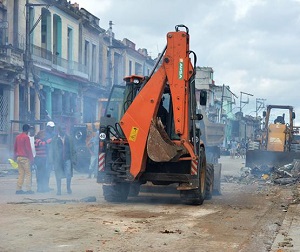 Past 8:00pm, the evening of January 28, Cuban President Miguel Díaz-Canel Bermúdez chaired another meeting of the Council of Ministers to evaluate progress being made on recovery efforts underway in Havana, after a tornado struck several capital city municipalities, the night of January 27.
Past 8:00pm, the evening of January 28, Cuban President Miguel Díaz-Canel Bermúdez chaired another meeting of the Council of Ministers to evaluate progress being made on recovery efforts underway in Havana, after a tornado struck several capital city municipalities, the night of January 27.
“Reinforcing attention to the population at times like these is vital,” the President insisted. Work was undertaken promptly, beginning immediately after the disaster, and it is imperative to explain to the people what is being done, he stated.
From this very moment, we must begin to gather all the experiences we have gained from this weather phenomenon, to incorporate them in plans for disaster prevention and risk reduction, he indicated.
Division General Ramón Pardo Guerra, head of the National Civil Defense General Staff, reported that, according to an aerial inspection conducted the morning of January 28, “The tornado developed close to the Casino Deportivo and weakened east of Alamar.
“Estimates indicate that it traveled a distance of 11.5 kilometers, at a speed of 42.6 kilometers an hour, over 16 minutes. It began with an impact diameter of 500 meters, later widening to 1,000 meters at the end of its course,” he explained.
At this point, he said, significant damages have been reported, such as total and partial building collapses, fallen trees and utility poles; broken doors and windows, as well as automobiles and containers dragged and turned over by the strong winds. Expeditious work began early on the clearing and collection of rubble across the city, he emphasized
The number of deaths caused by the extreme weather ascended to four and a total of 195 injuries had been reported, with these individuals receiving attention in several hospitals, according to Public Health Minister José Ángel Portal Miranda. Material damage is concentrated in the municipalities of Diez de Octubre, Regla, Guanabacoa, and San Miguel, he said, in 11 health care facilities.
The most difficult situation exists at the Hijas de Galicia Maternal Hospital, from which 196 patients were evacuated, 18 of whom were released and are now at home.
Regarding housing, Minister of Construction René Mesa Villafaña confirmed that the greatest amount of damage was to roof tops, which will need to be surveyed to begin deliveries of repair materials.
Luis Antonio Torres Iríbar, Party first secretary in Havana, reported that initial surveys indicate that the number of dwellings affected has reached 1,238, of which 123 are total collapses and 625 partial, along with 224 that have lost their roofs entirely, and 124 to a lesser degree.
Given this information, President Díaz-Canel indicated that, as soon as losses are specified, distribution of the necessary resources to the population is to begin – via the different established means – so that these problems can be alleviated as soon as possible.
In terms of reestablishing electrical service, Minister of Energy and Mines Raúl García Barreiro reported that the issue should be resolved by January 31. Damage is concentrated in overhead lines, including both transmission and distribution, while only two substations remain out of service, those in Berroa and Guanabacoa, he said.
Antonio Rodríguez Rodríguez, president of the National Water Resources Institute, reported that damage to the system has been repaired. Affected neighborhoods are being served via tank trucks and large water storage tanks have been placed at a variety of points, accessible to the population.
More than 13,000 telephone lines have been reported out of operation at this time, reported Jorge Luis Perdomo Di-Lella, minister of Communications, while 12 brigades of 80 linemen, with specialized vehicles, are already working to reestablish service. Work is underway, as well, on the mobile phone network and WiFi hotspots, as well as outdoor equipment, where the principal damages are concentrated.
The most significant agricultural impact was to tobacco, in the Pinar del Río municipalities of San Juan and San Luis, sector Minister Gustavo Rodríguez Rollero reported. Damage to fields and greenhouses in areas that experienced heavy rain are yet to be accurately determined, he said.
Iris Quiñones Rojas, minister of Food Industry, stated that during the dawn hours of the 28th, the preparation of bread was resumed, to ensure the basic regulated supply, despite the fact that 36 bakeries remain without electricity.
Some 48 means of automotive transport are estimated to have suffered some type of damage, said the sector Minister, Eduardo Rodríguez Dávila. At the time of the meeting, he reported, the central rail line had been re-opened, and the Regla ferry was operating by early that morning, as an important commuter service for the municipality.Minister of Economy and Planning Alejandro Gil Fernández reported that the main resources needed to begin recovery work are available.
Schools were projected to reopen January 29 at all of the city’s educational institutions, with alternate sites being prepared in some cases, to avoid affecting the academic year, said Minister of Education Ena Elsa Velázquez Cobiella.
It was reported that as recovery work advances, the communications media will continue promptly providing the people with all details.
(Granma)